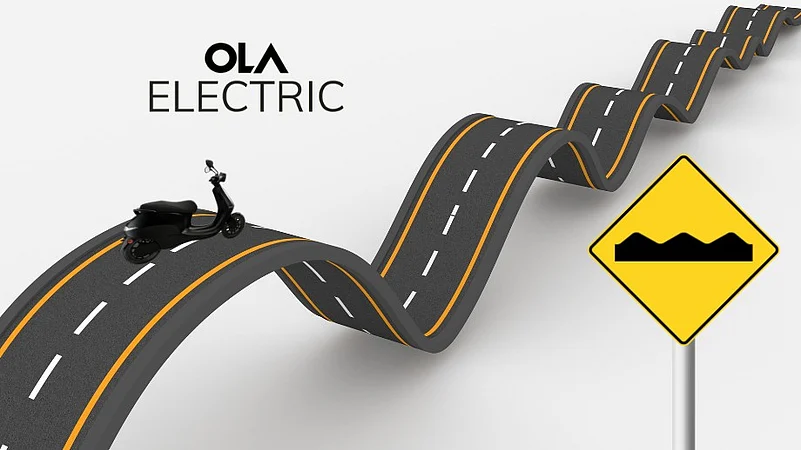All is well with Ola Electric? Well, the answer remains unclear. From increasing losses in q3 results and consumer complaints to falling stock prices and profitability in EBITDA margins --- the EV giant may face a bumpy ride in the EV (electronic vehicles) market. Yet, despite setbacks, Ola CEO Bhavish Aggarwal remains bullish.
The rush to expand quickly, probably for achieving profitability and increasing market share in two-wheelers EV segment, comes with its own set of challenges. The company has set a monthly sales run-target of 50,000 units for the next six months --- a key step toward breaking even at the earnings before interest, taxes, depreciation, and amortisation (EBITDA) level. In January, Ola’s retail sales were around 25,000 units.
The target may seem encouraging, but a closer look at numbers like quarterly results, market valuation, and stock price raises serious concerns.
Rising Q3 Losses, Sinking Revenue
Ola Electric reported a significant increase in its losses i.e., the EV company posted a net loss of Rs 564 crore for the third quarter of fiscal year 2025 as compared to Rs 376 crore in the year-ago period. And the company’s revenue from operations also witnessed a noticeable fall of 19% year-on-year to Rs 1,045 crore. In Q3FY24, Ola’s revenue stood at Rs 1,296 crore.
On a sequential basis, the company’s net loss widened from Rs 495 crore in Q2FY25, while revenue dropped from Rs 1,214 in the previous quarter. It also took some cost-cutting measures like huge discounts on scooters to reduce expenses. Despite this, Ola’s expenses reduced to Rs 1,505 crore from Rs 1,593 crore in Q2 but the company’s financial strain persisted, with losses mounted further in third quarter.
The company attributed the weak performance to high competitive intensity and service challenges. About a few months ago, Ola received over 10,000 consumer complaints regarding the quality of its scooters. Some videos even went viral on social media platforms which sparked a debate between comedian Kunal Kamra and Ola CEO over the product quality.
However, auto analysts have a slightly different view. “Its aggressive pricing strategy, including discounts exceeding 33% on certain models, has led to increased sales but at the expense of profitability. The company has reported huge losses due to these discounts,” said Kshiteej Mishra, Practice Member, Mobility, Energy and Transportation at Praxis Global Alliance.
While the company is driving up sales through heavy discounts, market analysts say that this approach may not be viable in the long run as it erodes profit margins and puts further pressure on finances amid rising competition from legacy players like Ather Energy, Bajaj Auto, and others.
They also suggested the company to focus on regaining customer trust --- compromised due to concerns over product quality and after sales services --- rather than just launching new products and increasing sales.
“Poor service quality has eroded user trust in the brand, necessitating significant investments to restore reputation. Intensifying competition from established players like Hero, TVS, and Bajaj is expected to further shrink margins, adding to the financial challenges,” said Mishra.All is well with Ola Electric? Well, the answer remains unclear. From increasing losses in q3 results and consumer complaints to falling stock prices and profitability in EBITDA margins --- the EV giant may face a bumpy ride in the EV (electronic vehicles) market. Yet, despite setbacks, Ola CEO Bhavish Aggarwal remains bullish.
The rush to expand quickly, probably for achieving profitability and increasing market share in two-wheeler EV segment, comes with its own set of challenges. The company has set a monthly sales run-target of 50,000 units for the next six months --- a key step toward breaking even at the earnings before interest, taxes, depreciation, and amortisation (EBITDA) level. In January, Ola’s retail sales were around 25,000 units.
The target may seem encouraging, but a closer look at numbers like quarterly results, market valuation, and stock price raises serious concerns.
Falling Stock Price, Market Cap
Ola Electric’s financial struggles also weigh its stock price and market capitalisation. The EV maker’s shares are trading nearly 20% below the IPO issue price of Rs 76 per share. The company made its public market debut in August last year, listing at Rs 75.99 apiece on the BSE and Rs 76 per share on the NSE.
A few days after the IPO launch, Ola’s share price skyrocketed to Rs 146.38 on the stock exchanges. However, the EV giant’s share price has been falling since then and reached Rs 59 on February 18, 2025. Similarly, the company’s market capitalisation also shows a downward trend. Currently, its market cap nearly stands at Rs 26,720.81 crore --- about 50% down from over Rs 60,000 crore in August 2024.
Foreign brokerage firms Goldman Sachs and Citi also reduced their target prices on Ola Electric after lower-than-expected performance in December quarter. Goldman Sachs brought Ola’s target price down by 14% to Rs 101 per share, while Citi lowered its target price from Rs 90 to Rs 85 apiece.
Read More | Ola Electric Q3 Net loss Widens to Rs 564 Crore
Breakeven Sales Target
Despite the concerning numbers, Ola Electric has directed attention to EBITDA margins. The company’s management expects that its auto segment will breakeven at 50,000 units per month of sales --- double the number of units (25,000) they sold in January 2025. Its Gen 3 scooters, along with new product addition like electric bike and electric-three wheeler, will also be included in this target.
And not to forget about the company’s store expansion plans; Ola has increased its network to 4,000 stores in December 2024 across the country. But the question arises: Will this breakeven target and massive expansion surely improve Ola’s financial health?
EBITDA is used to measure the company’s profitability because it focuses on core operations by excluding certain non-operating costs like interest, taxes, and depreciation. There is a significant portion of cost which exists below EBITDA --- lease expenses, major cost of retail-heavy businesses, depreciation, operating costs, interest on capital intensive plans, and more. This reflects the company’s true cost burden at the EBITDA level.
If we look at Ola’s example, the EV maker incurred Rs 60 crore in lease expenses in H1FY25 when it had 800 crores. But now with 4,000 stores, this figure is expected to swell further. Similarly, depreciation on more assets, interest amount on more borrowing for expansion, R&D, and other expenses will weigh more on the bottom line.
Hence, EBITDA breakeven is not the only indicator to analyse the company’s self-sustaining power. If Ola continues to burn cash in expenditures, the company needs to find out a way for profitability.
Go Beyond Expansion
Market experts believe that the service network expansion is crucial for Ola to address past service quality issues and build customer trust. However, balancing the costs of such expansion with the imperative to achieve profitability presents a significant challenge.
The risk of aggressive expansion isn’t new in the EV sector; companies like Fisker Inc. (an American EV manufacturer) and Hoonigan (an automotive aftermarket company) expanded rapidly but faced significant financial difficulties, leading to bankruptcy in 2024.
And Ola is already stretched across multiple priorities: aggressive pricing, rapid expansion, battery manufacturing, and high-end product development. According to Jinesh Gandhi, lead analyst for automobiles at Ambit Capital, the EV maker’s financial health is critical because it can’t sustain aggressive pricing beyond a point and the cash on books will get quickly consumed from losses along with capex plans.
VG Ramakrishnan, Managing Partner at Avanteum Advisors LLP said that the pathway to profitability for new-age EV companies is unclear because EVs disrupt the traditional way of making profits in the automobile sector --- selling spare parts, lubricants, and servicing.
“For EVs, the only way to achieve profitability is through direct sales --- either by increasing margins per unit or significantly scaling up volumes. Some OEMs also attempted to introduce additional revenue streams, such as telematics services, subscription-based features. But with modern smartphones, monetisation from these services remains uncertain,” he explained.
The only major aftermarket revenue opportunity for EVs is battery replacement. When vehicles come back for a battery change, companies can recover some of their initial costs, he said, while suggesting Ola to focus more on ‘after-sales services’ and regain customer trust.
"Ola’s future financial health will depend not just on selling more vehicles, but on whether it can achieve sustainable unit economics and differentiate itself in an increasingly competitive market. Legacy brands like TVS, Bajaj, and Ather have introduced solid products, and in a short time, they have gained significant market share,” said Ramakrishnan.
Also, it’s important to remember that sales targets aren’t just numbers on a company’s wish list; their success depends upon the readiness of buyers to use the product. In the case of electric vehicles, experts are skeptical if the Indian market is ready to accept EVs in large numbers, that too in such a short period. Market fundamentals must be solid enough for higher EV penetration rate, and the same hold true with Ola Electric.






























